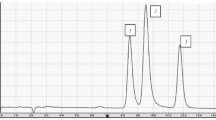Summary
Plasma concentrations and urinary excretion of DTZ and its metabolites were determined in 20 healthy volunteers (10 males and 10 females) after they had each been given a single oral 90 mg dose of DTZ. DTZ and six of its metabolites which included N-monodesmethyl DTZ (MA), deacetyl DTZ (M1), deacetyl N-monodesmethyl DTZ (M2), deacetyl O-desmethyl DTZ (M4) and deacetyl DTZ N-oxide (M1NO) and deacetyl N,O-didesmethyl DTZ (M6), were determined by a sensitive and specific HPLC assay. The major metabolites measurable in the plasma of all the volunteers were MA, M1, and M2. The terminal half-lives (t1/2) of M1 and M2 were considerably longer than those of DTZ and MA. Less than 5% of the dose was excreted as unchanged DTZ in the urine over the 24 h period. The major urinary metabolite was MA, followed by M6, M2, and then M1. Except for the urinary excretion of M4 there were no statistically significant differences in any of the pharmacokinetic parameters between the males and the females. The mean 24 h urinary recovery of M4 was higher in the males than in the females (P< 0.05). However there were large inter-individual variations in the plasma concentrations and urinary excretion of DTZ and its metabolites with some parameters differing by more than 20-fold. In addition, O-desmethyl DTZ (Mx) and N,O-didesmethyl DTZ (MB) were identified as two other major urinary metabolites.
Similar content being viewed by others
References
Bourassa M.G. (1985): Haemodynamic and electrophysiologic effects of diltiazem. Acta Pharmacol. Toxicol., 57, Suppl. II, 21–30.
Kendall M.J. Okopski J.V. (1986): Calcium antagonism-with special reference to diltiazem. J. Clin. Hosp. Pharm., 11, 159–174.
Halperin A.K., Cubeddu L.X., Albuquerque N.M. (1986): The role of calcium channel blockers in the treatment of hypertension. Am. Heart J., 111 (2), 363–382.
Meshi T., Sugihara J., Sato Y. (1971): Metabolic fate of d-cis-3-acetoxy-5-[2-(dimethylamino)ethyl]-2,3-dihydro-2-(p-methoxyphenyl)-1,5-benzothiazepin-4(5H)-one hydrochloride (CRD-401). Chem. Pharm. Bull., 19, 1546–1556.
Sugihara J., Sugawara Y., Ando H., Harigaya S., Etoh A., Kohno K. (1984): Studies on the metabolism of diltiazem in man. J. Pharmacobiodyn., 7, 24–32.
Yabana H., Nagao T., Sato M. (1985): Cardiovascular effects of the metabolites of diltiazem in dogs. J. Cardiovasc. Pharmacol., 7, 152–157.
Schoemaker H., Hicks P.E., Langer S.Z. (1987): Calcium channel receptor binding studies for diltiazem and its major metabolites: Functional correlation to inhibition of portal vein myogenic activity. J. Cardiovasc. Pharmacol., 9, 173–180.
Sugawara, Y., Ohashi M., Nakamura S., et al. (1988): Metabolism of diltiazem. I. Structures of new acidic and basic metabolites in rats, dog and man. J. Pharmacobiodyn., 11, 211–223.
Kiyomoto A., Sasaki Y., Odawara A., Morita T. (1983): Inhibition of platelet aggregation by diltiazem. Circ. Res., 52 (Suppl. 1), 115–119.
Yeung P.K.F., Mosher S.J., MacRae D.A., Klassen G.A. (1991): Effect of diltiazem and its metabolites on the uptake of adenosine in blood: An in-vitro investigation. J. Pharm. Pharmacol., 43, 685–689.
Kinney E.L., Moskowitz R.M., Zelis R. (1981): The pharmacokinetics and pharmacology of oral diltiazem in normal volunteers. J. Clin. Pharmacol., 21, 337–342.
Hermann P., Morselli P.L. (1985): Pharmacokinetics of diltiazem and other calcium entry blockers. Acta Pharmacol. Toxicol., 57 (Suppl. II), 10–20.
Montamat S.C., Abemethy D.R. (1987): N-monodesmethyldiltiazem is the predominant metabolite of diltiazem in the plasma of young and elderly hypertensives. Br. J. Clin. Pharmacol., 24, 185–189.
Hung J., Hackett P.L., Gordon S.P.F., Ilett K.F. (1988): Pharmacokinetics of diltiazem in patients with unstable angina pectoris. Clin. Pharmacol. Ther., 43, 466–470.
Hoglund P., Nilsson L.G. (1989): Pharmacokinetics of diltiazem and its metabolites after single and multiple dosing in healthy volunteers. Ther. Drug Monit., 11, 558–566.
Smith M.S., Verghese C.P., Shand D.G., Pritchett E.L.C. (1983): Pharmacokinetic and pharmacodynamic effects of diltiazem. Am. J. Cardiol., 51, 1369–1374.
Boyd R.A., Chin S.K., Don-Pedro O., et al. (1989): The pharmacokinetics and pharmacodynamics of diltiazem and its metabolites in healthy adults after a single oral dose. Clin. Pharmacol. Ther., 46, 408–419.
Klassen G.A., Yeung P.K.F., Hung O.R., Pollak P.T., Barclay K.D., Mosher S.J. (1993): Should gender differences guide therapeutics. Presented at the 42nd Annual Meeting of the American Colleges of Cardiology, March 1993, Anaheim, California, USA.
Yeung P.K.F., Montague T.J., Tsui B., McGregor C. (1989): High performance liquid chromatographic assay of diltiazem and six of its metabolites in plasma: Application to a pharmacokinetic study in healthy volunteers. J. Pharm. Sci., 78 (7), 592–597.
Li R., Farmer P.S., Xie M., et al. (1992): Synthesis, characterization and calcium antagonistic activity of diltiazem metabolites. J. Med. Chem., 35, 3246–3253.
Caille G., Boucher S., Spenard J., et al. (1991): Diltiazem pharmacokinetics in elderly volunteers after single and multiple doses. Eur. J. Drug Metab. Pharmacokinet., 16 (1), 75–80.
Goebel K.J., Kolle E.U. (1985): High performance liquid chromatographic determination of diltiazem and four of its metabolites in plasma: Application to pharmacokinetics. J. Chromatogr., 345, 355–363.
Hoglund P., Nilsson L.-G. (1987): Liquid chromatographic determination of diltiazem and its metabolites using trans isolid phase by addition of an amine to the mobile phase. J. Chromatogr., 414, 109–120.
Yeung P.K.F., Mosher S.J., Klassen G.A., McGilveray I.J. (1991): Stability of diltiazem and its metabolites in plasma during storage. Ther. Drug Monit., 13, 369–374.
Author information
Authors and Affiliations
Rights and permissions
About this article
Cite this article
Yeung, P.K.F., Prescott, C., Haddad, C. et al. Pharmacokinetics and metabolism of diltiazem in healthy males and females following a single oral dose. Eur. J. Drug Metab. Pharmacokinet. 18, 199–206 (1993). https://doi.org/10.1007/BF03188796
Received:
Issue Date:
DOI: https://doi.org/10.1007/BF03188796




